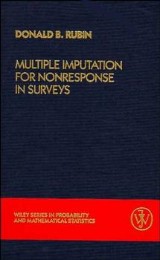Details

Multiple Imputation for Nonresponse in Surveys
Wiley Series in Probability and Statistics, Band 307 99. Aufl.
|
120,99 € |
|
| Verlag: | Wiley |
| Format: | |
| Veröffentl.: | 25.09.2009 |
| ISBN/EAN: | 9780470317365 |
| Sprache: | englisch |
| Anzahl Seiten: | 320 |
DRM-geschütztes eBook, Sie benötigen z.B. Adobe Digital Editions und eine Adobe ID zum Lesen.
Beschreibungen
Demonstrates how nonresponse in sample surveys and censuses can be handled by replacing each missing value with two or more multiple imputations. Clearly illustrates the advantages of modern computing to such handle surveys, and demonstrates the benefit of this statistical technique for researchers who must analyze them. Also presents the background for Bayesian and frequentist theory. After establishing that only standard complete-data methods are needed to analyze a multiply-imputed set, the text evaluates procedures in general circumstances, outlining specific procedures for creating imputations in both the ignorable and nonignorable cases. Examples and exercises reinforce ideas, and the interplay of Bayesian and frequentist ideas presents a unified picture of modern statistics.
Tables and Figures. <p>Glossary.</p> <p><b>1. Introduction.</b></p> <p>1.1 Overview.</p> <p>1.2 Examples of Surveys with Nonresponse.</p> <p>1.3 Properly Handling Nonresponse.</p> <p>1.4 Single Imputation.</p> <p>1.5 Multiple Imputation.</p> <p>1.6 Numerical Example Using Multiple Imputation.</p> <p>1.7 Guidance for the Reader.</p> <p><b>2. Statistical Background.</b></p> <p>2.1 Introduction.</p> <p>2.2 Variables in the Finite Population.</p> <p>2.3 Probability Distributions and Related Calculations.</p> <p>2.4 Probability Specifications for Indicator Variables.</p> <p>2.5 Probability Specifications for (<i>X,Y</i>).</p> <p>2.6 Bayesian Inference for a Population Quality.</p> <p>2.7 Interval Estimation.</p> <p>2.8 Bayesian Procedures for Constructing Interval Estimates, Including Significance Levels and Point Estimates.</p> <p>2.9 Evaluating the Performance of Procedures.</p> <p>2.10 Similarity of Bayesian and Randomization-Based Inferences in Many Practical Cases.</p> <p><b>3. Underlying Bayesian Theory.</b></p> <p>3.1 Introduction and Summary of Repeated-Imputation Inferences.</p> <p>3.2 Key Results for Analysis When the Multiple Imputations are Repeated Draws from the Posterior Distribution of the Missing Values.</p> <p>3.3 Inference for Scalar Estimands from a Modest Number of Repeated Completed-Data Means and Variances.</p> <p>3.4 Significance Levels for Multicomponent Estimands from a Modest Number of Repeated Completed-Data Means and Variance-Covariance Matrices.</p> <p>3.5 Significance Levels from Repeated Completed-Data Significance Levels.</p> <p>3.6 Relating the Completed-Data and Completed-Data Posterior Distributions When the Sampling Mechanism is Ignorable.</p> <p><b>4. Randomization-Based Evaluations.</b></p> <p>4.1 Introduction.</p> <p>4.2 General Conditions for the Randomization-Validity of Infinite-<i>m</i> Repeated-Imputation Inferences.</p> <p>4.3Examples of Proper and Improper Imputation Methods in a Simple Case with Ignorable Nonresponse.</p> <p>4.4 Further Discussion of Proper Imputation Methods.</p> <p>4.5 The Asymptotic Distibution of (&Qmacr;<sub><i>m</i></sub>,Ū<sub><i>m</i></sub>,B<sub><i>m</i></sub>) for Proper Imputation Methods.</p> <p>4.6 Evaluations of Finite-<i>m</i> Inferences with Scalar Estimands.</p> <p>4.7 Evaluation of Significance Levels from the Moment-Based Statistics D<sub>m</sub> and &Dtilde;<sub>m</sub> with Multicomponent Estimands.</p> <p>4.8 Evaluation of Significance Levels Based on Repeated Significance Levels.</p> <p><b>5. Procedures with Ignorable Nonresponse.</b></p> <p>5.1 Introduction.</p> <p>5.2 Creating Imputed Values under an Explicit Model.</p> <p>5.3 Some Explicit Imputation Models with Univariate <i>Y</i><sub>I</sub> and Covariates.</p> <p>5.4 Monotone Patterns of Missingness in Multivariate <i>Y</i><sub>I</sub>.</p> <p>5.5 Missing Social Security Benefits in the Current Population Survey.</p> <p>5.6 Beyond Monotone Missingness.</p> <p><b>6. Procedures with Nonignorable Nonresponse.</b></p> <p>6.1 Introduction.</p> <p>6.2 Nonignorable Nonresponse with Univariate <i>Y</i><sub>I</sub> and No <i>X</i><sub>I</sub>.</p> <p>6.3 Formal Tasks with Nonignorable Nonresponse.</p> <p>6.4 Illustrating Mixture Modeling Using Educational Testing Service Data.</p> <p>6.5 Illustrating Selection Modeling Using CPS Data.</p> <p>6.6 Extensions to Surveys with Follow-Ups.</p> <p>6.7 Follow-Up Response in a Survey of Drinking Behavior Among Men of Retirement Age.</p> <p>References.</p> <p>Author Index.</p> <p>Subject Index.</p> <p>Appendix I. Report Written for the Social Security Administration in 1977.</p> <p>Appendix II. Report Written for the Census Bureau in 1983.</p>
<b>Donald B. Rubin , PhD,</b> is a John L. Loeb Professor of Statistics at Harvard University in Cambridge, MA. He was named 2000-2001 Statistician of the Year by the Chicago Chapter of ASA. His research interests include causal inference in experiments and observational studies, developing and applying statistical models to data in a variety of scientific disciplines, and the application of Bayesian and empirical Bayesian techniques.
The <b>Wiley Classics Library</b> consists of selected books that have become recognized classics in their respective fields. With these new unabridged and inexpensive editions, Wiley hopes to extend the life of these important works by making them available to future generations of mathematicians and scientists.
Diese Produkte könnten Sie auch interessieren:

Nonparametric Regression Methods for Longitudinal Data Analysis

von: Hulin Wu, Jin-Ting Zhang

135,99 €

Statistics and the Evaluation of Evidence for Forensic Scientists

von: Colin Aitken, Franco Taroni

103,99 €














